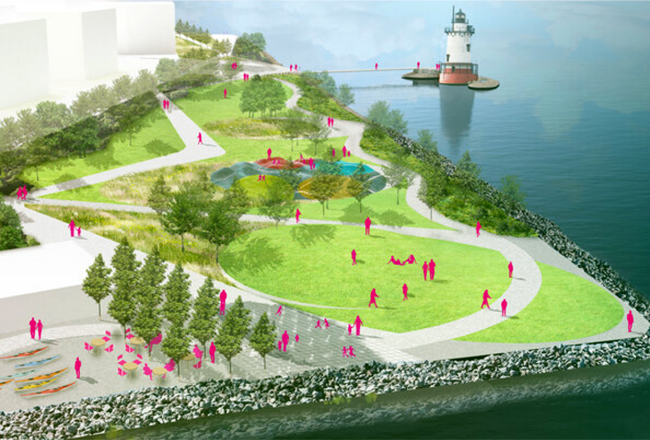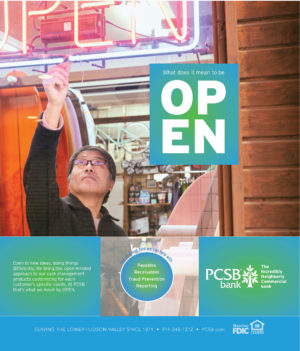Edge-on-Hudson a catalyst for enriching Sleepy Hollow and the riverfront
The importance of parks for cities, urban areas and historically underserved communities was underscored on Feb. 11 when President Biden”™s acting Secretary of the Interior Scott de la Vega reversed an order put into effect in the final days of the Trump administration that had gutted a federal program supporting parks and greenspace projects.
On the way out of office, Trump”™s Interior Secretary David Bernhardt stripped the Land and Water Conservation Fund (LWCF) and Outdoor Recreation Legacy Partnership (ORLP) of their funding. Bernhardt”™s action followed Congress in a bipartisan move increasing LWCF funding to $900 million while also adding $100 million to ORLP”™s funding, which brought to $125 million the total available in 2021 for competitive grants to help develop parks in populated areas.

New York is one of the states that has benefited from partnership funding in the past with the state”™s Office of Parks, Recreation, and Historic Preservation handling grant applications. There is wide appreciation of the recreational, aesthetic and economic value that can come from parks and it is exemplified in what”™s been happening in Sleepy Hollow.
Despite the pandemic and winter weather, a section of the Hudson River waterfront has already been opened up in the first phase of construction on a park associated with the Edge-on-Hudson development.
Edge-on-Hudson is a mixed-use community being developed on 70 acres that used to be home to General Motors. New York City-based Biddle Real Estate Ventures (BREV) and PCD Development, based in New Providence, New Jersey, are the master developers of the project.
The plans call for 1,177 housing units consisting of rental and condominium apartments along with townhomes, a 140-room hotel, 135,000 square feet of retail space and 35,000 square feet of office space along with more than 16 acres of parkland. A new DeCicco & Sons food market was announced for the site. The estimated final value of the project is $1 billion.
A waterfront park designed by Nelson Byrd Woltz Landscape Architects, the half-mile-long Sleepy Hollow RiverWalk at Edge-on-Hudson, is being built to link with other trails and parks. The architects worked with Sleepy Hollow”™s Open Space Council on the design for more than two years. Completion is expected in early 2022.
The path will become part of a much a larger park system embodied in the Hudson River Valley Greenway that includes, among other features, Kingsland Point Park along the Hudson River waterfront, Horseman”™s Trail along the Pocantico River, the Rockefeller State Park Preserve and various elements from the Battery in Lower Manhattan all the way to Albany.
While the developers are paying most of the park”™s first-phase $2 million design and construction costs, a $500,000 grant from the state”™s Empire State Development Market New York program is helping to expedite the project.
“People today, especially the people who are attracted to our community, don”™t want the typical suburban-style fortress home; they want to be in an integrated, mixed-use community,” Peter Chavkin, founder of BREV, told the Business Journal.
“We have this amazing waterfront. When you are standing on our southern edge, you see the Manhattan skyline in the distance yet when you go 50 feet west and you look upriver the Palisades and that section on the other side of the river look pristine. You can almost envision that it looks just as it did about five hundred years ago when Henry Hudson came up the river.”
Chavkin said what they”™re building will not be a private park and they saw it as an opportunity to bring not just an amenity for the residents but to be a draw of regional significance.
“The village of Sleepy Hollow will own this park forever,” Chavkin said. “If you think about it, this site for the better part of 100 years was locked off. When General Motors was operating here this represented the bulk of Sleepy Hollow”™s waterfront and now we”™re giving it back to the village, but not just giving it back to them, creating something new that never existed before.”
“We get this new parkland that we”™ve never had before and, especially after this year we”™ve just had, it”™s so obvious just how important parkland is to any community,” Sleepy Hollow Mayor Ken Wray told the Business Journal. “You have to have public gathering spaces for folks and this is just an incredible asset.”
Wray said he believes the park also will become a major asset for the village”™s business community because it will attract people who will then visit the downtown and patronize stores and restaurants.
“We said ”˜We want the riverfront to be open to the public; it cannot be private and it will be good for your development as well,”™ and ultimately that view prevailed,” Wray said.
“What the Edge folks have been really great about is keeping the riverfront open whenever they can, whenever construction allows it. All during the summers you”™ve seen thousands of people coming to the riverfront even though it wasn”™t developed; it was a construction site. But, the fact that you”™re on the river was incredibly beautiful.”
Wray said there has been an uptick in interest in the downtown because of Edge-on-Hudson.
“When the pandemic really set in we had just completed an update of our comprehensive plan and we”™re beginning to implement pieces of that including looking at rezoning our downtown to help with that development and attract more investment,” Wray said.
“The Edge project has been doing very well despite the pandemic. The Edge project has made it possible for us to develop The Common, 28 acres on the other side of the Metro-North tracks with new recreational facilities, new parkland, moving our Department of Public Works off the riverfront into this site as well. This is a $60 million project, which for a village like ours, is huge but it”™s being made possible because the Edge project is underway.”
Wray envisioned people being able to come to Sleepy Hollow via Metro-North and enjoy the park network, shopping, dining and facilities being planned for the waterfront.
“People are responding to what Edge-on-Hudson provides; an urban aesthetic in a village setting,” Chavkin said. “For someone who”™s coming out of New York City it”™s fairly priced for Westchester but you”™re also getting more space. We”™ve seen a lot of buyers coming up from the city. Toll Brothers sold a tremendous number of townhomes on the site last year and we”™ve just gotten approval from Sleepy Hollow”™s Planning Board for the next batch of townhomes. The design is distinctive.”
